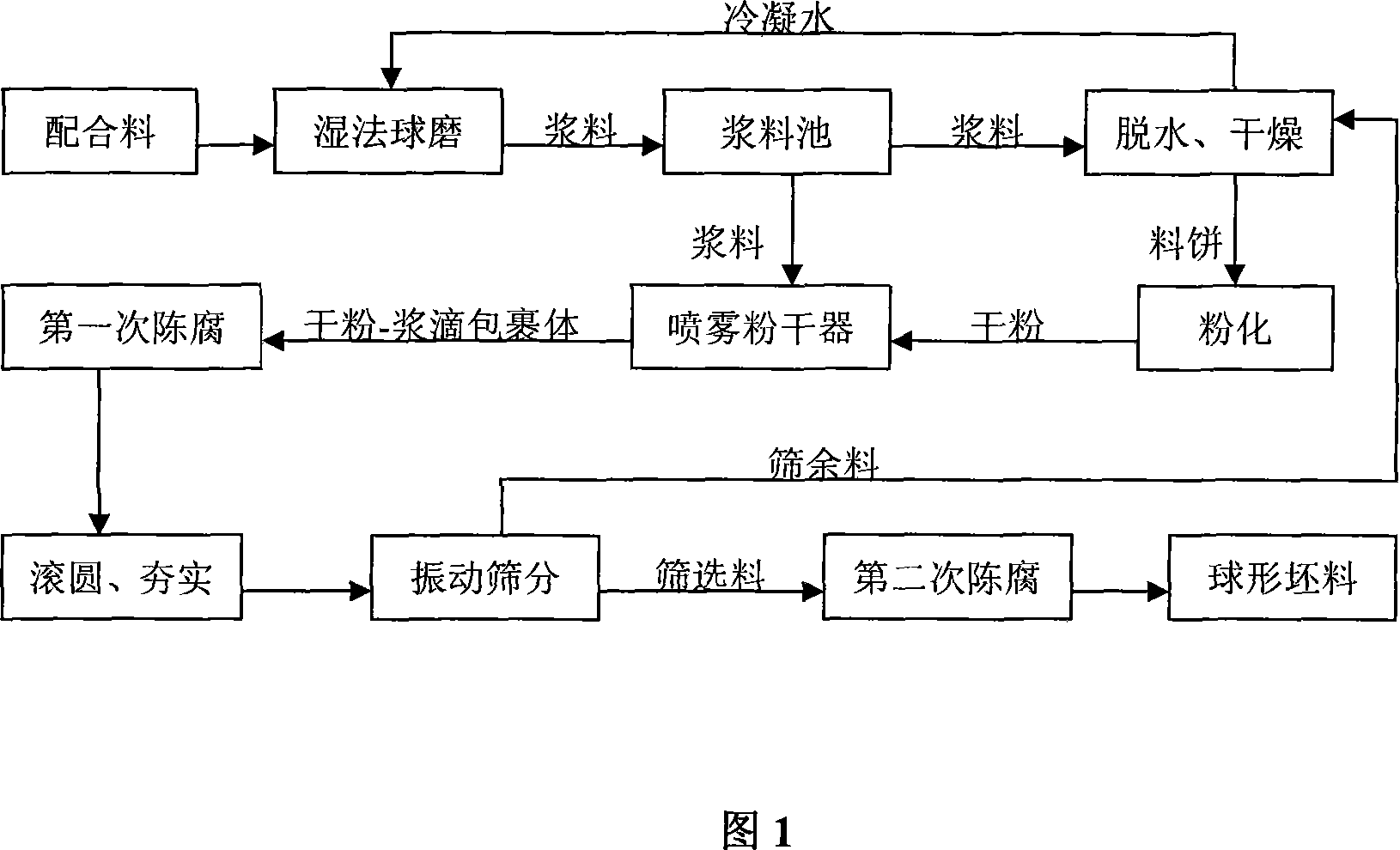Technology for preparing blank for constructive ceramic with semi-drying method
A semi-dry technology for architectural ceramics, applied in clay preparation equipment, clay processing equipment, chemical instruments and methods, etc., can solve problems such as susceptibility to iron pollution, poor material uniformity, tail gas pollution, etc., to reduce drying heat low energy consumption, easy purification and treatment, and little air pollution
- Summary
- Abstract
- Description
- Claims
- Application Information
AI Technical Summary
Problems solved by technology
Method used
Image
Examples
Embodiment 1
[0041] As shown in Figure 1, a kind of semi-dry method prepares the technique of building ceramics blank, it comprises the following steps:
[0042] (1) Batching: According to the proportioning of conventional building ceramics production raw materials, weighing (mass percentage): 39.0% feldspar, 13.0% quartz sand, 45.0% clay, 3.0% talc, put into the ball mill;
[0043] (2) Wet ball milling: the raw material is finely ground into a slurry in a ball mill by using a conventional wet ball milling process, the water content of the slurry is 35% (mass), and the particle size is less than 2% (mass) after the sieve residue on a 10,000-hole sieve;
[0044] (3) Iron removal and sieving: the slurry is passed through a magnetic separator to remove iron impurities in the slurry, and then passed through a 140 mesh sieve to screen out coarse particles, flow into the slurry pool, and store as the slurry for subsequent use;
[0045] (4) Preparation of dry powder: dehydrating and drying a part...
Embodiment 2
[0052] A semi-dry method for preparing blanks for architectural ceramics, comprising the following steps:
[0053] (1) Batching: According to the proportioning of conventional building ceramics production raw materials, weighing (mass percentage): 39.0% feldspar, 13.0% quartz sand, 45.0% clay, 3.0% talc, put into the ball mill;
[0054] (2) Wet ball milling: the raw material is finely ground into a slurry in a ball mill by using a conventional wet ball milling process, the moisture content of the slurry is 33% (mass), and the particle size is less than 2% (mass) after the sieve residue on the 10,000-hole sieve;
[0055] (3) Iron removal and sieving: the slurry is passed through a magnetic separator to remove iron impurities in the slurry, and then passed through a 140 mesh sieve to screen out coarse particles, flow into the slurry pool, and store as the slurry for subsequent use;
[0056] (4) Preparation of dry powder: dehydrating and drying a part of the slurry obtained in st...
Embodiment 3
[0063] A semi-dry method for preparing blanks for architectural ceramics, comprising the following steps:
[0064] (1) Batching: According to the proportioning of conventional building ceramics production raw materials, weighing (mass percentage): 39.0% feldspar, 13.0% quartz sand, 45.0% clay, 3.0% talc, put into the ball mill;
[0065] (2) Wet ball milling: the raw materials are finely ground into a slurry in a ball mill by conventional wet ball milling process, the moisture content of the slurry is 38% (mass), and the particle size is less than 2% (mass) after the sieve residue on a million-hole sieve;
[0066] (3) Iron removal and sieving: the slurry is passed through a magnetic separator to remove iron impurities in the slurry, and then passed through a 140 mesh sieve to screen out coarse particles, flow into the slurry pool, and store as the slurry for subsequent use;
[0067] (4) Preparation of dry powder: dehydrating and drying a part of the slurry obtained in step (3) ...
PUM
| Property | Measurement | Unit |
|---|---|---|
| particle size | aaaaa | aaaaa |
| particle size | aaaaa | aaaaa |
| particle size | aaaaa | aaaaa |
Abstract
Description
Claims
Application Information
 Login to View More
Login to View More - R&D
- Intellectual Property
- Life Sciences
- Materials
- Tech Scout
- Unparalleled Data Quality
- Higher Quality Content
- 60% Fewer Hallucinations
Browse by: Latest US Patents, China's latest patents, Technical Efficacy Thesaurus, Application Domain, Technology Topic, Popular Technical Reports.
© 2025 PatSnap. All rights reserved.Legal|Privacy policy|Modern Slavery Act Transparency Statement|Sitemap|About US| Contact US: help@patsnap.com

